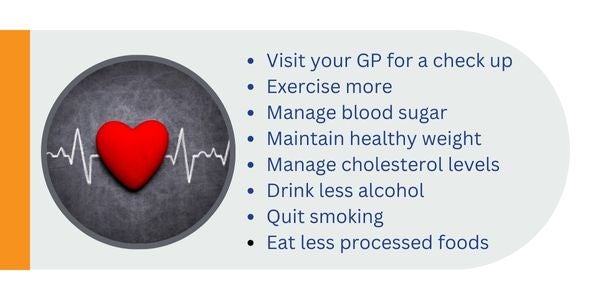
Make your heart health a priority
Make your heart health a priority

Making better choices today can positively impact your tomorrow and this rings true when taking a preventative approach to heart health. As the center of your cardiovascular system, the function of your heart is vitally responsible for just about everything that gives your body life.
Heart health goals
Keeping your heart healthy is something you can work on every day. Set yourself simple goals like improving your diet, increasing how much you move, removing harmful lifestyle behaviours, and/or having regular check ups with your health provider to monitor/assess your level of heart disease risk.

The impact of heart attack in Australia
A heart attack occurs when a major blood vessel or artery becomes blocked. When this happens, vital oxygen can no longer be fed to the heart muscle, and it begins to die.
The blockage is caused by a buildup of plaque or fatty deposits within the heart vessels. It is a condition commonly referred to as coronary heart disease.
- In Australia, coronary heart disease is the leading cause of death.
- Heart attacks are responsible for causing almost one in 20 deaths.
- Twice as many men experience heart attacks compared to females.
Source: The Heart Foundation.
Inside I-MED - CT Calcium Score Interview
Watch as one of our experienced CT radiographer's sheds light on CT Calcium Scoring. Discover how this test can estimate the future risk of a heart attack or stroke for asymptomatic individuals.
A CT scan can estimate your future risk of heart attack
A coronary artery calcium score is a measurement of calcium deposits (that occur during plaque formation) in the arteries that supply the heart muscle with blood. It is measured by taking a special computed tomography (CT) scan of the heart. The results of the scan are used to estimate the risk of a heart attack in the next 5–10 years. The more calcified plaque there is, the higher the risk of a heart attack.
This test is generally recommended in men and women above the age of 45 years who are not symptomatic of any cardiac disease (i.e., chest pain or shortness of breath).
What the calcium score represents
- 0 (zero): lowest cardiac risk. (Predicted 10-year risk is only 1%)
- 1-10: trivial calcification
- 10 - 100: mild calcification
- 100 - 400: moderate calcification
- > 400: severe calcification
A calcium score > 400 predicts between a 30-50% ten-year risk of heart attack, depending on other risk factors present.
How do I arrange a CT calcium scoring test?
You must speak to your GP about whether a CT Calcium Score is appropriate for you. If recommended by your doctor, they will write you a radiology referral.
To make an appointment, visit I-MED Radiology’s online booking portal and follow the screen prompts. Alternatively, you can contact your local clinic by phone here, and one of our friendly staff will assist you.
Other cardiac imaging
The following cardiac imaging examinations might be requested by your GP or specialist if heart disease is suspected, or you have a known heart condition.
Echocardiography
Echocardiography is an ultrasound examination of your heart. It is a test in which high frequency sound waves are used to create a moving picture of your heart. It is often the first-line cardiac imaging investigation for many cardiac conditions. Find out more here.
Cardiac MRI
Cardiac MRI uses very strong magnetic fields and radiofrequency pulses to obtain both still and moving images of the heart and surrounding blood vessels to aid in the diagnosis and management of cardiovascular diseases. It is used to detect abnormalities that may not be seen with other imaging modalities. Find out more here.
CT Coronary Angiogram (CTCA)
CTCA uses computed tomography (CT) scanning to generate images of the coronary arteries of the heart. Your doctor may refer you for a CTCA to determine if you have narrowing of the coronary arteries, which could be causing the symptoms you’re experiencing. Find out more here.
Myocardial perfusion imaging
A myocardial perfusion scan can visualise the perfusion (blood flow) to the heart muscle through the coronary arteries. To complete the test, an image of the blood flow is obtained under both “rest” and “stress” conditions - which helps determine whether the heart muscle is receiving adequate blood flow when it is needed. Find out more here.
Why you can trust I-MED Radiology
Our team of content writers create website materials that adhere to the principals set out in content guidelines, to ensure accuracy and fairness for our patients. Dr. Ronald Shnier, our Chief Medical Officer, personally oversees the fact-checking process, drawing from his extensive 30-year experience and specialised training in radiology.
